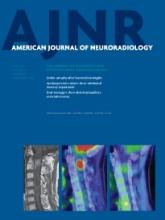Research ArticleSpine Imaging and Spine Image-Guided InterventionsF
Spinal Meningeal Diverticula in Spontaneous Intracranial Hypotension: Analysis of Prevalence and Myelographic Appearance
P.G. Kranz, S.S. Stinnett, K.T. Huang and L. Gray
American Journal of Neuroradiology June 2013, 34 (6) 1284-1289; DOI: https://doi.org/10.3174/ajnr.A3359
P.G. Kranz
aFrom the Departments of Radiology (P.G.K., K.T.H., L.G.)
S.S. Stinnett
bBiostatistics and Bioinformatics (S.S.S.)
cOphthalmology (S.S.S.), Duke University Medical Center, Durham, North Carolina.
K.T. Huang
aFrom the Departments of Radiology (P.G.K., K.T.H., L.G.)
L. Gray
aFrom the Departments of Radiology (P.G.K., K.T.H., L.G.)

Submit a Response to This Article
Jump to comment:
No eLetters have been published for this article.
In this issue
Advertisement
P.G. Kranz, S.S. Stinnett, K.T. Huang, L. Gray
Spinal Meningeal Diverticula in Spontaneous Intracranial Hypotension: Analysis of Prevalence and Myelographic Appearance
American Journal of Neuroradiology Jun 2013, 34 (6) 1284-1289; DOI: 10.3174/ajnr.A3359
Jump to section
Related Articles
- No related articles found.
Cited By...
- Prevalence and Characteristics of Microspurs in Patients with Spontaneous Intracranial Hypotension Compared with the General Population
- Prevalence of Spinal Meningeal Diverticula in Autosomal Dominant Polycystic Kidney Disease
- Monro-Kellie Hypothesis: Increase of Ventricular CSF Volume after Surgical Closure of a Spinal Dural Leak in Patients with Spontaneous Intracranial Hypotension
- Spontaneous Intracranial Hypotension: Atypical Radiologic Appearances, Imaging Mimickers, and Clinical Look-Alikes
- Diskogenic microspurs as a major cause of intractable spontaneous intracranial hypotension
- A classification system of spontaneous spinal CSF leaks
This article has not yet been cited by articles in journals that are participating in Crossref Cited-by Linking.
More in this TOC Section
Similar Articles
Advertisement











